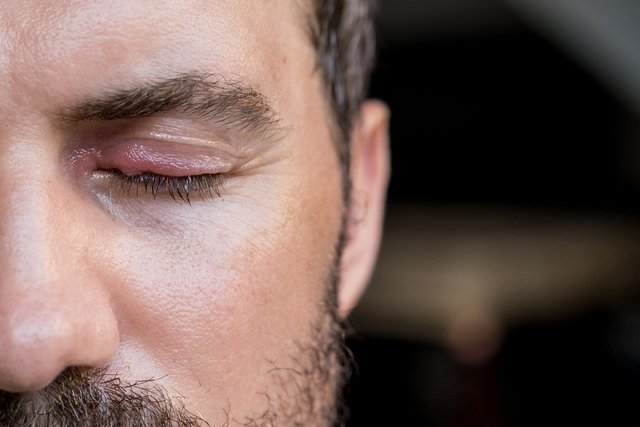A swollen eyelid can occur as a result of many conditions, like a stye, blepharitis, chalazion or improper use of contact lenses. These situations can be easily resolved by applying wet, hot compresses over they eye and maintaining adequate hygiene of the eyes.
This symptom may also be a sign of conjunctivitis, ocular cellulitis, herpes in the eyes or Graves’ disease. These conditions require assessment by an ophthalmologist, who will be able to indicate the most appropriate treatment.
Swollen eyelids should be assessed by your doctor, and require immediate medical attention if it is also accompanied by difficulty breathing, vision loss, double vision or tearing of the eyes that does not stop.

The main causes of a swollen eyelid are:
1. Allergies
Allergies are one of the most common causes of swollen eyelids, and can be triggered by a food, an inhaled substance or through direct contact of an allergen with the skin. In addition to swelling, you may also notice redness in the eyes, tearing and itchiness. Respiratory allergies can also cause sneezing and runny nose.
What to do: It is important to identify the underlying trigger so that this product or substance can be avoided. A doctor may prescribe anti-histamine eyedrops to relieve symptoms and decrease swelling.
2. Inadequate use of contact lenses
The incorrect use or improper cleansing of contact lenses can also cause eye irritation and increase the risk for infection. This can result in swollen eyelids, red eyes, and dry skin around the eyes.
What to do: To prevent complications from contact lens use, you should wash your hands before touching the lenses, remove them prior to sleeping, and wash them regularly in a disinfectant.
3. Stye
A stye is the inflammation of a small gland in the eyelid caused by a bacterial infection. With a stye, the eyelid becomes swollen and the small pimple-like lump appears on the eyelid edge. Patients usually experience discomfort when blinking, increased light sensitivity and tearing.
What to do: In most cases, styes will disappear on their own without any treatment within 3 to 5 days. However, to speed-up recovery, you can apply a warm water compress on the affected eyelid for 10 to 15 minutes, 3 to 4 times per day. Read about more natural remedies to get rid of a stye that you can try at home.
4. Conjunctivitis
Conjunctivitis is an inflammation of the eye that can occur due to a viral or bacterial infection or due to an allergy. It is associated with symptoms like swollen eyelids, redness and itchy eyes.
What to do: You should consult an opthalmologist to identify the type of conjunctivitis present, and to start appropriate treatment. Treatment may involve the use of eyedrops to moisten the eyes, or anti-inflammatories or antibiotics for bacterial conjunctivitis.
5. Blepharitis
Blepharitis is an inflammation of the meibomian gland. This gland is located in the eyelid and is responsible for keeping the eyes moist. When this gland becomes inflamed, fat and oil is more difficult to eliminate through the pores, and they start to accumulate within the eyelids. This leads to swelling and crusting discharge.
What to do: To treat blepharitis, you are advised to cleanse the eyes and remove any crust with the indicated eyedrops. You can also apply a warm water compress 3 to 4 times per day for 3 minutes until symptoms resolves.
6. Chalazion
Like blepharitis, chalazions are characterized by inflammation of the meibomian gland that becomes obstructed and forms a small cyst. The more the discharge within the cyst start to accumulate, the larger the cyst becomes, leading to swollen eye lids, pain and eye irritation.
What to do: Chalazions usually disappear on their own within 8 weeks. To speed up recovery, you can apply a warm water compress on the eye 2 to 3 times per day.
7. Orbital cellulitis
Orbital cellulitis is a common childhood condition that occurs due to inflammation in the eye socket and the surround structures. It leads to swelling, redness, fever, pain and difficulty moving the eye.
What to do: You should consult an opthalmologist, who will order testing to identify the microorganism causing the inflammation. Once identifies, the most effective antibiotic can be initiated.
8. Eye herpes
Eye herpes is an infection caused by the Herpes simplex virus. It can cause itching, irritation, red eyes, swollen eyelids and blisters around the eyes.
What to do: You are advised to see an ophthalmologist or family doctor for assessment. Antiviral medication may be prescribed to neutralize the virus and relieve symptoms.
9. Graves’ disease
Graves’ disease occurs due to abnormal functioning of the thyroid gland. In addition to swollen eyelids, patients may experience itchy eyes, excessive tearing and double vision.
What to do: You should consult an endocrinologist, who can evaluate your current thyroid hormone levels and indicate treatment that will help relieve symptoms. The doctor may prescribe thyroid medications, radioactive iodine or even surgery depending on the intensity of symptoms.
